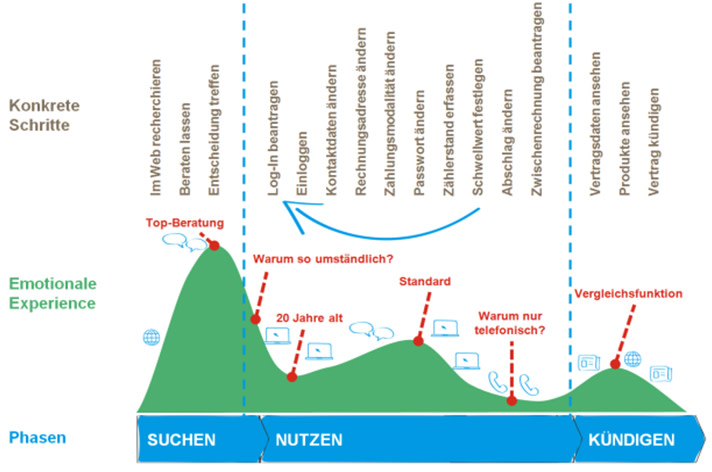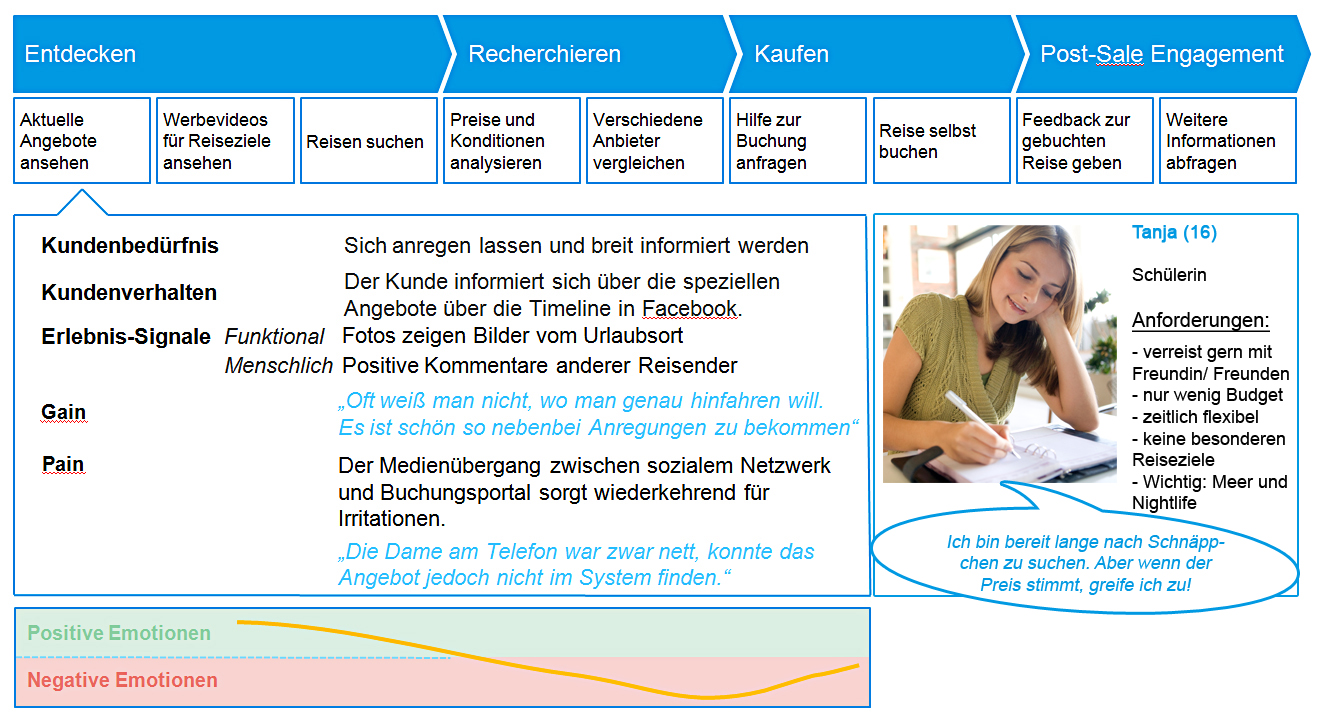Customer Journey Map as an access to true user orientation

More and more companies understand that a user-driven business model is more advantageous than a product-driven business model to be successful in the long run. The user is the judge of a product’s value and it is his/her experiences that determine whether and how often the product or further products of the same enterprise are purchased and used. Thus, a consistently positive user experience has to be the goal of every company. This applies not only for consumer products but also for business solutions and especially for services.
What exactly is a consistently positive user experience? Are a usable product and an attentive call-center-service sufficient?
Company structures are not relevant for users and their experience. However, companies are often not able to ignore internal structures and processes. But optimizing single services (such as the hotline quality) often does not result in the anticipated improvement of the user experience.
What means do companies have to improve the relation to their users?
(Re-) designing a positive relation with users is a multistage process and should be considered as strategic management. A reorganization of internal processes in the company can often accompany this process to satisfy customer needs sufficiently.
The process begins with understanding the current situation from the customers’ perspective.
What are the users’ experiences with the product/ company? How do they evaluate the company’s user-oriented behavior?
What are the user needs and requirements?
What are the touch points of users with the company and its products? How do they evaluate the transition from one touchpoint to another?
Answering this kind of questions helps to find calls for action regarding the real user orientation. Getting to know the view of actual or potential users can be an eye-opener, as this view often diverges from corporate thinking.
In this post an instrument to capture the current situation from the users’ point of view is presented: the Customer Journey Map.
What exactly is a Customer Journey Map?
The Customer Journey Map can help to capture the complete user experience from the first to the last contact with the company and the product(s). At each user’s interaction step D-LABS collects the following information:
- Touch points: tools (such as a website), people (such as sales officers), documents (such as flyers) or physical rooms (such as service branches)
- User behavior: behavior of the users (e.g. surfing a website) and their expressed remarks
- Experience signals:functional, physical and/ or human signals the users sense during the interaction
- Pains & Gains: factors that elicit satisfaction or even excitement (gains) and factors that interfere with a user’s way to achieve his/ her goals (pains)
- Emotions: emotional reaction to experience signals, touch points, etc.
What is special about the Customer Journey Map is that it captures all information graphically in one document – a map which visualizes the overall experience vividly. At D-LABS, we do not use a fixed canvas but adapt the format of the results according to industry, product and depth of detail. Due to a wealth of details, the end product is often an A1/ A2- Poster that shows key insights and the view of the users at a glance.
In order not to mix up different needs, requirements and varying experiences of different target groups, it makes sense to have a single map for every target group. Personas (prototypes of user groups with concrete characteristics and concrete user behavior) are especially useful, as the “journey” of these target groups is visualized in very memorable way.
In order to find deviations from the users’ point of view, it can also be beneficial to capture the company’s internal point of view of the interaction quality beforehand.
In the following example an extract of a Customer Journey Map from a travel agency (Figure 1) is presented. The travel agency offers several touch points: there is a website, special offers are communicated via social media and direct contact is possible with a 24h-hotline. The Customer Journey was divided in four main interaction steps. The target group in the example, represented by persona Tanja (16), is the group of young people who are flexible and who prioritize price over destination. Due to limited space, only the results of the first interaction step (scout current offers) at the touch point social media are depicted.

Figure 1: Customer Journey Map – an example [extract]
The considered target group is pleased with the presentation of information in the social media. Thus, at this touch point there is no call for action. However, the transition to the next step – analyzing prices and conditions (via the touch point hotline) - does not work smoothly. This results in negative emotions and can possibly lead to the termination of the interaction. Clearly, there is room for improvement for the transitions between touch points.
Finally…
A Customer Journey Map is a powerful tool to explore user’s needs, to find deviations between internal and users’ points of view and to communicate user requirements within the company.
This method presents the interaction with a product or a company as a continuing process from the user’s point of view independent of internal company’s structures. This enables the creation of truly user-centred products and services and ensures user’s loyalty.
A Customer Journey Map can also be the starting point of internal restructuring processes, if present structures do not match the users’ needs. In the named example, it may be sensible to improve the collaboration of social media and the hotline division.

Contact
14482 Potsdam
potsdam@d-labs.com
10245 Berlin
berlin@d-labs.com
70173 Stuttgart
stuttgart@d-labs.com
